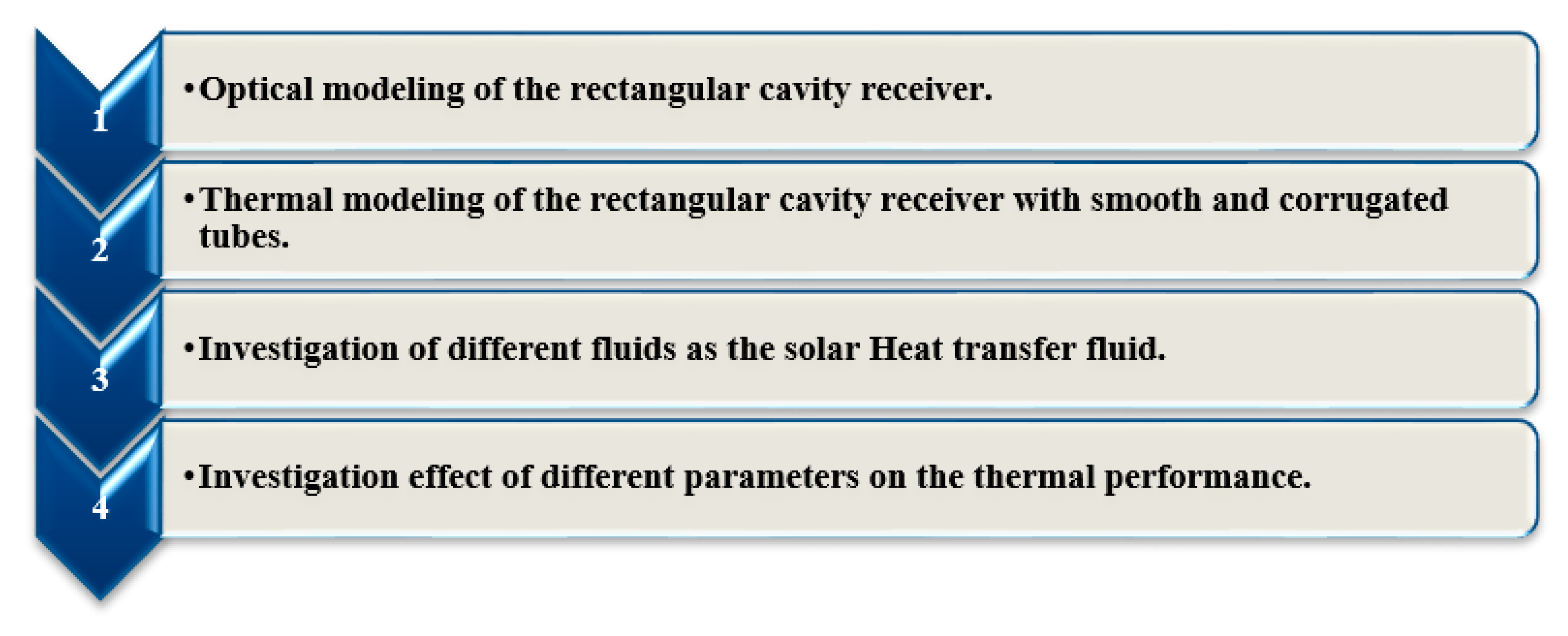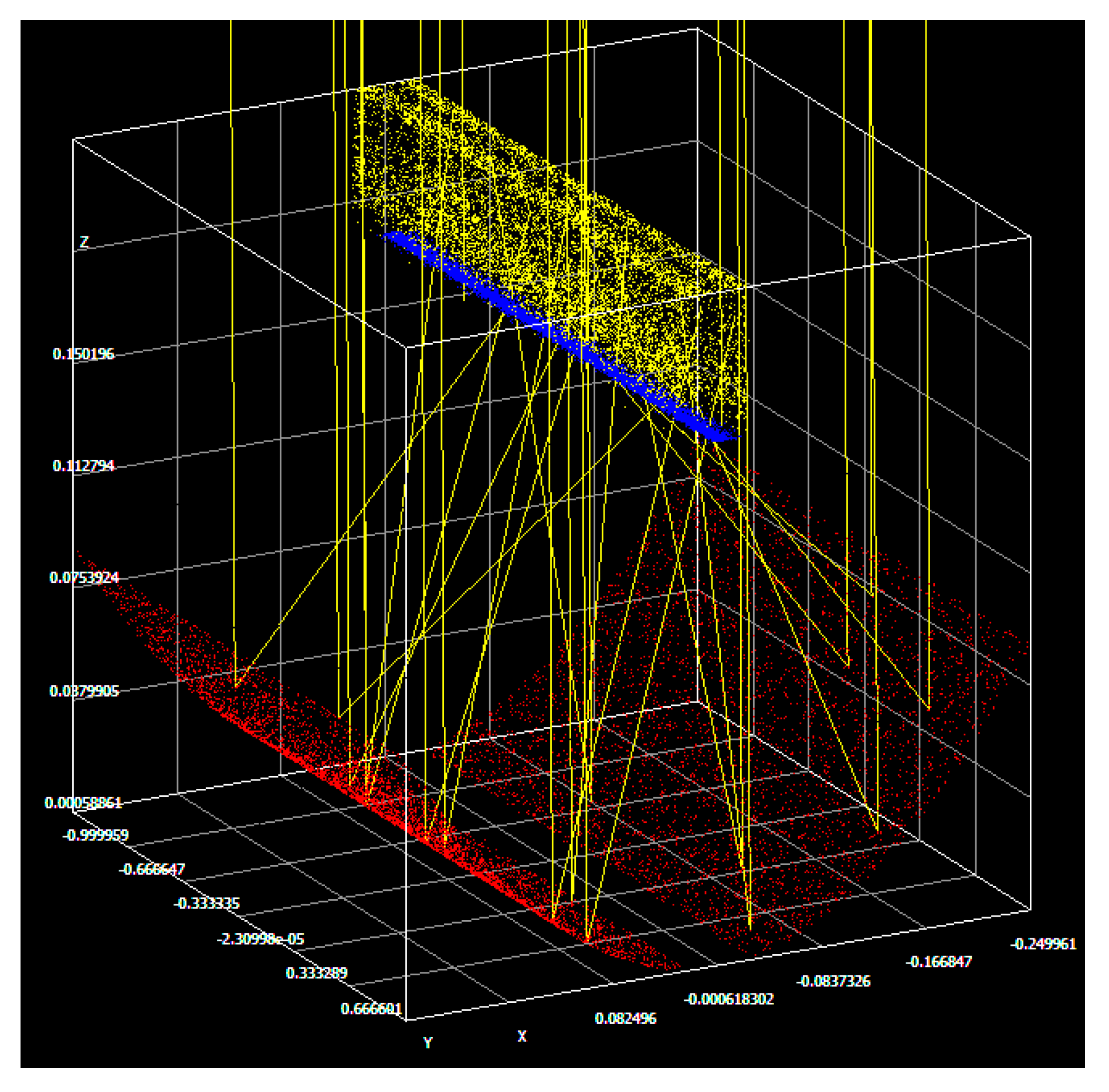1. Introduction
Today, renewable energy is investigated as promising technique for reducing the environmental problem due to fossil fuel application [
1]. There are different kinds of the renewable energies for power generation, including solar energy, wind power, geothermal energy, etc. [
2]. The solar energy is suggested as an interesting kind of the renewable energy for providing the requested social energy [
3]. The solar energy can be converted in the form of thermal energy using solar collectors [
4]. Generally, the solar collectors behave as a heat exchanger for converting the solar energy to the internal thermal energy of solar heat transfer fluids that are flowing in the solar collectors. The solar collectors can be divided as concentrator collectors and non-concentrator collectors [
5,
6,
7]. The concentrator collectors have a higher aperture area compared to the absorber aperture area. In other words, all of the incoming solar beam irradiation will be concentrated at a focal point of focal line where the absorber will be located [
8]. The concentrator collectors are used for medium to high-temperature application [
9,
10].
Parabolic trough concentrators (PTCs) are accounted for as a kind of the solar concentrators [
11,
12]. Generally, there are two types of receiver for the PTCs, including conventional receiver and cavity receivers. The conventional receivers consist of a receiver tube with a glass cover where the solar heat transfer fluid enters from one side and exits from another side [
13,
14]. Generally, the cavity receivers, due to special structure, have higher thermal performance compared to the conventional receivers [
15]. Most parts of the incoming solar beam irradiation at the cavity aperture will be absorbed by cavity tubes due to the radiation and re-radiation. The outsides of the cavity receiver, except for the cavity aperture, are covered by insulation for reducing the cavity heat losses [
16]. In addition, the cavity aperture is covered with a glass for decreasing the radiation and convection heat losses from the cavity aperture. This superior structure of the cavity receiver is introduced as an effective and interesting shape of receiver in the concentrator solar collectors.
Much research has numerically and experimentally investigated cavity receivers as the solar absorber in solar concentrators. Yan et al. [
17] optimized a cylindrical cavity receiver as the solar receiver of a dish concentrator. They presented a new type of dish concentrator as the solar concentrator with some discrete mirrors. They studied application of the solar dish concentrator with the cavity receiver for power generation. Yang et al. [
18] suggested a new type of a cavity receiver for a dish concentrator. They found that the suggested new design of the cavity receiver has a higher thermal performance compared to conventional receivers. Loni et al. [
19] numerically considered different cavity shapes, including a rectangular, cylindrical, and hemispherical, for the cavity receiver. Different solar heat transfer fluids were considered, including water and thermal oil. They concluded that the hemispherical cavity receiver has the highest performance compared to other investigated cavity receivers. In addition, good agreement was found between the numerical and experimental results. Uzair et al. [
20] investigated heat losses from a dish concentrator with cavity receiver. The effect of wind speed and inclination angle of wind was numerically studied. They found that the dish orientation and position of the dish concentrator has an effective influence on the cavity heat losses.
Yang et al. [
21] proposed a new shape of modified cavity receiver with forced air circulation system to reduce the convective heat loss. They found that the anticlockwise mode of the air circulation caused higher performance for reducing heat losses. Soltani et al. [
22] optically and thermally studied a cylindrical cavity receiver based on a new numerical method. They found some optimum parameters where the cavity performance can be improved by selecting them during the cavity design. Karimi et al. [
23] investigated thermal performance of a cylindrical cavity receiver in detail. Loni et al. [
24] experimentally tested a cylindrical cavity receiver with carbon nanotube/oil nanofluid as the solar heat transfer fluid. They suggested some equations for thermal performance prediction for the cylindrical cavity receiver with the nanofluid and pure oil as the solar heat transfer fluid.
In addition, there has been some research related to the application of linear cavity receiver in solar concentrators, such as Fresnel collectors. Tsekouras et al. [
25] investigated a linear Fresnel system with a linear rectangular cavity. They evaluated thermal performance and cavity heat losses of the cavity receiver under variation of heat transfer fluid inlet temperature. Roostaee and Ameri [
26] optimized a linear Fresnel collector with a cavity receiver thermally. They found that the optimized parameters have an effective influence on the collector performance. Dabiri et al. [
27] evaluated heat losses of a linear Fresnel collector with a rectangular cavity receiver. They found that the heat losses enhanced by increasing cavity angle. Lin et al. [
28] numerically and experimentally studied a linear Fresnel collector with different shapes of cavity receiver. They considered the linear Fresnel collector optically and thermally.
Reddy and Kumar [
29] numerically considered a linear Fresnel collector with a rectangular cavity receiver. They studied heat losses of the cavity receiver under variation of cavity aperture area, cavity temperature, and wind speed. They concluded that the cavity structure ca be optimized by minimizing the cavity heat losses. Qiu et al. [
30] optically and thermally considered a linear Fresnel collector with a rectangular cavity receiver. They found that the cavity coating is an important parameter for achieving the highest optical and thermal performance. Finally, some researchers numerically investigated cavity receivers as the absorber of solar PTC. Liang et al. [
31] suggested a new design of a cavity receiver for a solar PTC system. The numerical modeling was validated, based on some experimental tests. They found that the cavity thermal performance can be improved by improving the physical property parameters of the collector. Liang et al. [
32] investigated heat losses from a PTC system using a cavity receiver. Application of a cover was suggested for the PTC system with the cavity receiver. They found that the thermal performance of the PTC can be improved using the movable cover. Bader et al. [
33] numerically investigated a solar PTC system with a new design of cavity receiver. Different cavity receivers were investigated with air as the solar heat transfer fluid. The system was optically and thermally considered.
As seen from the aforementioned literature review, application of cavity receiver in solar concentrator systems is an interesting subject for improving thermal performance. In the current research, a PTC system with a tubular cavity receiver was investigated. A rectangular cavity receiver with smooth and corrugated tube was studied. Different solar heat transfer fluids were considered, including water, air, and thermal oil. The main aim of this research was thermal investigation of the PTC using the cavity receiver using different types of cavity tube, as well as different solar heat transfer fluids. In addition, the effect of different parameters was investigated, including solar beam irradiation, inlet temperature, and flow rate of the heat transfer fluid.






























